
As the debate over the state’s water supply rages on, the South Florida Water Management District (SFWMD) is reporting additional progress on phosphorus reduction in the Everglades Agricultural Area (EAA).
Phosphorus is one of several elements that can contribute to the growth of toxic algae in Florida’s waterways. Data from SFWMD shows phosphorus discharges dropped 59% in the 2021 water year — which ended April 30 — as compared to the base period established in the 1994 Everglades Forever Act.
Each year, officials measure the amount of phosphorus loads at points of discharge in the EAA against “the total phosphorus load that would have occurred during the 1979-1988 base period,” according to the act’s language. The 1994 law set up incentives to keep phosphorus discharges at least 25% below the levels seen during that base period.
Water year 2021 saw a reduction more than double that target number.
Phosphorus, which can run off from farms in the area, had been a driver of pollution in Florida’s waterways — particularly in Lake Okeechobee — in decades past. Pushed in part by the 1994 Everglades Forever Act, farmers have worked to reduce phosphorus runoff, resulting in an average 55% drop in those phosphorus discharges since 1996, as compared to the base period.
“While many folks may use ‘clean water’ as a bumper sticker or fundraising slogan, Florida sugarcane and vegetable farmers have a 25-year record of success that demonstrates our commitment to cleaning every drop of water before it leaves our farms,” said Judy Sanchez, senior director for corporate communications and public affairs for U.S. Sugar.
“Farmers in the EAA are a great example of how clean water and growing fresh, locally-grown food go hand in hand.”
Keeping runoff of those elements low is important in protecting the health of Florida’s ecosystem, the SFWMD explains.
“These nutrients flow across the landscape in stormwater runoff as pollution (urban and agricultural) harming natural areas by promoting algae growth and an overabundance of non-native plants, crowding out natural vegetation and disrupting food sources and habitats used by native wildlife. The Everglades is naturally a low-nutrient system. Even small amounts of additional nutrients can upset the ecological balance needed by the native plants and animals,” the agency writes.
Relaxed regulation led to a major lawsuit in the late 1980s asking that runoff be cleaned more thoroughly. In the decades since, farmers say they’ve worked to use best practices to lessen pollution and toxic runoff.
The 59% reduction in water year 2021 marks the fourth year in the past five that phosphorus levels have dropped by at least that much. Over the last five years, the EAA has seen phosphorus levels 62% lower on average as compared to the base period.
“This past year was challenging for Florida farmers given the demands created by the global pandemic; however, farmers always rise to the challenge, especially when it comes to caring for our water resources,” Sanchez added.
“This achievement underscores the fact that over the past 25 years, Florida sugarcane and vegetable farmers growing food in the Everglades Agricultural Area have been reliable partners in the state and federal government’s ongoing efforts to restore South Florida’s ecosystem.”
The news comes as the debate on where to send water discharged from Lake Okeechobee continues. That water too can contain toxic algae. When discharged, the water can carry algae into other waterways, allowing it to spread to other communities.
Last month, the U.S. Army Corps of Engineers revealed a proposed update to its Lake Okeechobee regulation plan, which triggered a series of barbs back and forth regarding the plan’s efficacy.
In that area too, sugar farmers have worked to lower their impact on the lake’s algal blooms. As reported by the South Florida Sun-Sentinel in 2016, less than 6% of the phosphorus in Lake Okeechobee came from land south of Lake Okeechobee as flood protection for the communities on the “southern rim of the lake.”
“Sugarcane farmers’ efforts to date in reducing phosphorus is an American success story,” said Keith Wedgworth, President of the Western Palm Beach Farm Bureau.
“Our Best Management Practices are world-class and best of all, we are cleaning the water while growing fresh produce nearly 180 million Americans depend on in the winter months every year.”
The state has also done its part to improve water quality in the Everglades. Gov. Ron DeSantis has prioritized projects related to Everglades restoration since taking office in 2019. Earlier this month, he announced the state had completed its removal of a portion of the Old Tamiami Trail roadbed. That project will help increase the amount of water flowing into the Everglades and Everglades National Park.

One comment
Bull Sugar
August 17, 2021 at 10:01 am
This “success” is the result of decades in court and a federal consent decree, not any altruism on the part of industrial agricultural corporations.
P.S. You’re also ignoring the nitrogen and sulfur in the runoff.
Comments are closed.